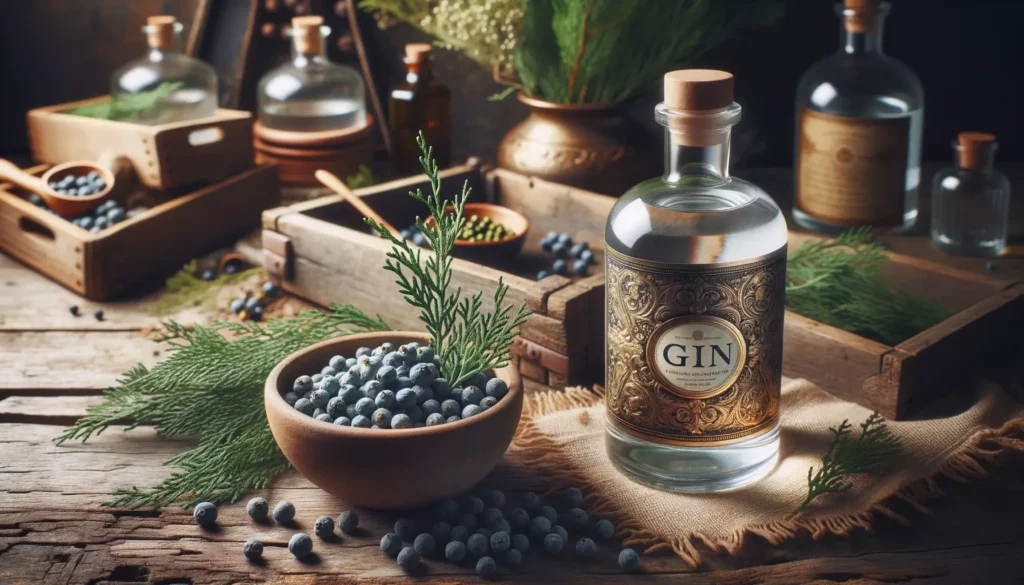In this post, we look at an extensive collection of gin facts and statistics that cut through the noise and get right to the good stuff.
We’re peeling back the layers of this beloved spirit, exploring its rich history, uncovering production secrets, and celebrating its global influence.
Packed with facts and figures, this post is here to transform you into a gin guru, no matter where you are on your gin journey.
So, whether you’re a die-hard Gin fan or just starting to dip your toes into the spirits world, by the end of this post you’ll be a lot more educated about Gin than you are right now!
Let’s get into it…
Key takeaways:
1. Total global gin consumption is expected to rise 4.4% during the period 2018-2023.
2. The global gin market was valued at $14.03 billion in 2020 and is projected to reach $20.17 billion by 2028, growing at a CAGR of 4.9% during the forecast period 2021 to 2028.
3. The global gin market is highly competitive due to multiple regional and multinational companies.
4. Local ingredients, like heather in Scotland, are commonly used in gin production.
5. British naval officers got a daily ration of gin.
Key Gin Facts
So, you think you know gin? Well, there’s always something new to learn about this fantastic spirit.
In this section, we’re looking into some interesting gin facts that touch on everything from its different styles and flavors to the way it’s made.
Did you know gin can be made from more than just grain? And that its alcohol content usually hangs out between 40% and 50%.
Yep, gin’s got some surprises up its sleeve, and this post is going to reveal them.
- The growth of the global gin market is majorly driven by modernization in developing countries, the emergence of modern on-trades, and the increasing consumption of alcohol among the young and millennial population worldwide.
- The gin market offers several alcoholic drinks to consumers such as beer, wine, and spirits of which gin is gaining huge popularity overseas.
- The global gin market is segmented into type, price point, distribution channel, and region. By type, the market is segmented into London dry gin, old tom gin, Plymouth gin, and others. By distribution channel, the market is segmented into on-trade and off-trade. By price point, the market is classified into standard, premium, and luxury gins.
- The global gin market is highly competitive due to multiple regional and multinational companies.
- South Africa is among those nations with a bourgeoning thirst for gin. The CAGR for gin consumption between 2013 and 2018 was an astounding 27.65%, rising from 518,000 nine-litre cases in 2013 to almost 1.8m in 2018.
- The country with the world’s highest per-capita gin consumption is the Philippines, with an estimated 25 million cases consumed annually.
- The Gin market worldwide is projected to grow by 7.71% (2023-2027) resulting in a market volume of US$19.95bn in 2027.
- Total gin consumption in the UK was over 6 million nine-litre cases in 2018 and is expected to rise to over 10 million cases by 2023.
- The UK is the world’s largest exporter of gin, with over 315 distilleries in operation at the beginning of 2018.
- Gin consumption in Nigeria and Uganda is forecast to grow by 0.4% and 4.5%, respectively, between 2018 and 2023.· Gin’s origins are Dutch, and it was called “jenever”.
>> Read more: 45 MUST-KNOW Wine Statistics
Gin Statistics
Gin stands out in the spirits world not only for its unique flavors but also for its impressive market presence.
Gordon’s holds the title of the world’s best-selling gin, while other brands like Bombay Sapphire are instantly recognizable by their iconic packaging.
The United States and the United Kingdom are major consumers of gin, contributing to the significant growth of the industry in the 21st century.
The gin market is diverse, boasting hundreds of brands and even the world’s strongest gin at 149.4 proof, showcasing the spirit’s wide appeal and enduring popularity.
- The gin market size is expected to grow from 0.82 billion liters in 2023 to 1.07 billion liters by 2028, at a CAGR of 5.38% during the forecast period (2023-2028).
- Total global gin consumption is expected to rise 4.4% during the period 2018-2023.
- Europe is one of the major consumers that accounted for more than 50% of the overall gin market share in 2020.
- The global gin market was valued at $14.03 billion in 2020 and is projected to reach $20.17 billion by 2028, growing at a CAGR of 4.9% during the forecast period 2021 to 2028.
- Gin is often made using botanicals that are added to the base spirit before distillation and then steeped.
>> Read more: 41 Super INTERESTING Beer Statistics
Gin History
The journey of gin from its Dutch origins to its British transformation is marked by significant historical and social events.
The British Navy played a pivotal role, adopting gin as a daily ration for officers. England’s relationship with gin has been tumultuous, with periods of overconsumption leading to regulatory acts such as the Gin Act of 1751.
Despite these challenges, gin has emerged as a beloved spirit, with a rich history that continues to captivate and inspire.
- Botanicals are commonly introduced to the base spirit prior to the distillation process when making gin.
- In some gin production methods, botanicals are infused after the distillation of the base spirit.
- The method of steeping botanicals in the base spirit is a frequent practice in gin making.
- A popular gin production technique involves distilling the botanicals together with the base spirit.
- Some gins are crafted by first distilling botanicals separately and then blending them together.
- Maceration of botanicals is a prevalent technique used in the gin production process.
- Infusing botanicals is a well-established method in the creation of gin.
- The unique flavor of some gins is achieved by smoking the botanicals used in production.
- Roasting botanicals is another technique employed to impart distinct flavors to gin.
- Drying botanicals in a kiln is a traditional method utilized in the gin-making process.
>> Read more: 45 FASCINATING Happy Hour Statistics
Gin Production
The production of gin is an intricate art, requiring a careful balance of botanicals and distillation techniques.
Juniper berries, essential to gin’s flavor, are often complemented by botanicals such as coriander, citrus peel, and cardamom.
The production process varies, with some gins distilled alongside their botanicals and others blending separately distilled components.
The choice of base spirit and distillation method, whether in copper stills or otherwise, significantly influences the final product’s flavor profile.
As the industry evolves, small-batch production and sustainable practices are becoming increasingly prevalent, highlighting the distilleries’ commitment to quality and environmental responsibility.
- The sun-drying process is a common method for preparing botanicals used in gin production.
- Many gins incorporate hand-picked botanicals to enhance their unique flavors.
- Some distilleries cultivate their own botanicals specifically for use in their gin.
- Locally sourced botanicals are a popular choice for creating distinct gin varieties.
- Fair trade practices are employed in sourcing the botanicals for certain gins.
- Sustainable botanicals are a key ingredient in many environmentally-conscious gin brands.
- The use of organic botanicals is a hallmark of some premium gin varieties.
- Foraged ingredients, including wildflowers and herbs, are often utilized in gin making.
- Innovative gins sometimes incorporate unusual botanicals, such as seaweed, for a unique flavor profile.
- Seasonal botanicals, like elderflower in springtime, play a special role in some gin recipes.
- Wild-picked juniper berries are a primary ingredient in nearly all gin varieties.
>> Read more: 55 SHOCKING Bar Industry Statistics
Gin Consumption
Gin’s versatility is showcased in its consumption, with options ranging from straight or on the rocks to a key ingredient in classic cocktails.

The Gin and Tonic, made with gin, tonic water, and a slice of citrus, remains a timeless favorite, enjoyed in various settings and cultures.
Gin’s low-calorie content, at just 20 calories per centiliter, adds to its appeal for health-conscious consumers.
Beyond beverages, gin’s botanical notes lend themselves to culinary applications, further broadening the spirit’s reach and versatility.
- Botanicals such as cardamom and saffron add an exotic touch to many gin recipes.
- Local ingredients, like heather in Scotland, are commonly used in gin production.
- A diverse array of botanicals, including coriander, angelica root, and citrus peel, are staples in gin making.
- The “compound gin” technique, which involves steeping botanicals in the base spirit, is a prevalent method.
- Some gins are crafted using the “distilled gin” method, where a neutral spirit is redistilled with the botanicals.
- The “London dry” gin production method includes distilling the base spirit along with the botanicals.
- Many distilleries opt for small-batch production to create their gin.
- Copper stills are a popular choice for the distillation process in gin-making.
- While strongly associated with British culture, gin enjoys widespread popularity in Spain and beyond.
- Typically a clear spirit, gin also comes in barrel-aged varieties, which are gaining in popularity.
>> Read more: 44 CAPTIVATING Rum Statistics
Gin Culture and Trends
This set of statistics really gets to the heart of gin’s cultural impact and the fresh trends shaping its journey today.
We’re seeing a surge in gin bars and small-batch distilleries, and let’s not forget all those gin-centric events and festivals popping up everywhere.
These numbers are more than just digits; they tell the story of gin’s undying popularity and its transformative journey through today’s society.
So, if you want to understand how gin continues to enchant us all and set new trends in the spirits world, you’re in the right place.
These stats lay it all out, showcasing Gin’s powerful presence and influence.
- Gin is often used in cooking, particularly in desserts.
- Gin is a versatile spirit that can be used in many cocktails.
- The country with the world’s highest per-capita gin consumption is the Philippines, with an estimated 25 million cases consumed annually.
- The gin rickey was the most popular gin drink of the late 19th and early 20th centuries.
- Gin and tonic was invented by the British in India as a way to make quinine more palatable.
- British naval officers got a daily ration of gin.
- Gin was used as a hangover cure in New York City in 1928.
- Gin doesn’t have a shelf life.
- Gin is a low-calorie drink, with only 20 calories per centiliter.
- Gin’s primary flavor is the sweet pine and soft citrus of the juniper berry.
>> Read more: 47 MUST-SEE Cocktail Trends & Statistics
Sources:
- https://www.alliedmarketresearch.com/gin-market-A11469
- https://www.alliedmarketresearch.com/gin-market-A11469
- https://www.alliedmarketresearch.com/gin-market-A11469
- https://www.mordorintelligence.com/industry-reports/gin-market
- https://www.theiwsr.com/news-and-comment-provenance-and-profits-the-future-of-the-gin-industry/
- https://sipsmith.com/us/50-surprising-gin-facts/
- https://www.statista.com/outlook/cmo/alcoholic-drinks/spirits/gin/worldwide
- https://www.theiwsr.com/news-and-comment-provenance-and-profits-the-future-of-the-gin-industry/
- https://www.theiwsr.com/news-and-comment-provenance-and-profits-the-future-of-the-gin-industry/
- https://www.theiwsr.com/news-and-comment-provenance-and-profits-the-future-of-the-gin-industry/
- https://www.mordorintelligence.com/industry-reports/gin-market
- https://www.theiwsr.com/news-and-comment-provenance-and-profits-the-future-of-the-gin-industry/
- https://www.alliedmarketresearch.com/gin-market-A11469
- https://www.alliedmarketresearch.com/gin-market-A11469
- https://exmoordistillery.co.uk/gin-fun-facts/
- https://exmoordistillery.co.uk/gin-fun-facts/
- https://exmoordistillery.co.uk/gin-fun-facts/
- https://exmoordistillery.co.uk/gin-fun-facts/
- https://exmoordistillery.co.uk/gin-fun-facts/
- https://exmoordistillery.co.uk/gin-fun-facts/
- https://exmoordistillery.co.uk/gin-fun-facts/
- https://exmoordistillery.co.uk/gin-fun-facts/
- https://exmoordistillery.co.uk/gin-fun-facts/
- https://exmoordistillery.co.uk/gin-fun-facts/
- https://exmoordistillery.co.uk/gin-fun-facts/
- https://exmoordistillery.co.uk/gin-fun-facts/
- https://exmoordistillery.co.uk/gin-fun-facts/
- https://exmoordistillery.co.uk/gin-fun-facts/
- https://exmoordistillery.co.uk/gin-fun-facts/
- https://exmoordistillery.co.uk/gin-fun-facts/
- https://exmoordistillery.co.uk/gin-fun-facts/
- https://exmoordistillery.co.uk/gin-fun-facts/
- https://exmoordistillery.co.uk/gin-fun-facts/
- https://exmoordistillery.co.uk/gin-fun-facts/
- https://exmoordistillery.co.uk/gin-fun-facts/
- https://exmoordistillery.co.uk/gin-fun-facts/
- https://exmoordistillery.co.uk/gin-fun-facts/
- https://exmoordistillery.co.uk/gin-fun-facts/
- https://exmoordistillery.co.uk/gin-fun-facts/
- https://exmoordistillery.co.uk/gin-fun-facts/
- https://exmoordistillery.co.uk/gin-fun-facts/
- https://exmoordistillery.co.uk/gin-fun-facts/
- https://exmoordistillery.co.uk/gin-fun-facts/
- https://exmoordistillery.co.uk/gin-fun-facts/
- https://exmoordistillery.co.uk/gin-fun-facts/
- https://exmoordistillery.co.uk/gin-fun-facts/
- https://exmoordistillery.co.uk/gin-fun-facts/
- https://exmoordistillery.co.uk/gin-fun-facts/
- https://sipsmith.com/us/50-surprising-gin-facts/
- https://sipsmith.com/us/50-surprising-gin-facts/
- https://sipsmith.com/us/50-surprising-gin-facts/
- https://sipsmith.com/us/50-surprising-gin-facts/
- https://sipsmith.com/us/50-surprising-gin-facts/
- https://exmoordistillery.co.uk/gin-fun-facts/
- https://world-gin-club.com/gin-facts-figures/
- https://sipsmith.com/us/50-surprising-gin-facts/


